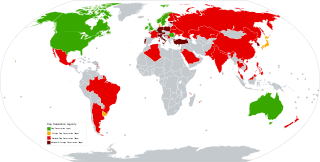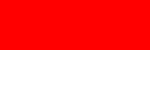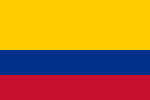
A national flag is a flag that represents and symbolizes a given nation. It is flown by the government of that nation, but can also be flown by its citizens. A national flag is typically designed with specific meanings for its colours and symbols, which may also be used separately from the flag as a symbol of the nation. The design of a national flag is sometimes altered after the occurrence of important historical events. The burning or destruction of a national flag is a greatly symbolic act.

A coat of arms is a heraldic visual design on an escutcheon, surcoat, or tabard. The coat of arms on an escutcheon forms the central element of the full heraldic achievement, which in its whole consists of a shield, supporters, a crest, and a motto. A coat of arms is traditionally unique to the armiger. The term "coat of arms" itself, describing in modern times just the heraldic design, originates from the description of the entire medieval chainmail "surcoat" garment used in combat or preparation for the latter.

The national flag of Romania is a tricolour. The Constitution of Romania states that "The flag of Romania is tricolour; the colours are arranged vertically in the following order from the flagpole: blue, yellow, red". The flag has a width-length ratio of 2:3; the proportions, shades of colour as well as the flag protocol were established by law in 1994, and extended in 2001. Its similarity to the flag of Chad has caused international discussion.
Flag terminology is the nomenclature, or system of terms, used in vexillology, the study of flags, to describe precisely the parts, patterns, and other attributes of flags and their display.

The hammer and sickle is a communist symbol representing proletarian solidarity between agricultural and industrial workers. It was first adopted during the Russian Revolution at the end of World War I, the hammer representing workers and the sickle representing the peasants.

The national flag of Hungary is a horizontal tricolour of red, white and green. In this exact form, it has been the official flag of Hungary since 23 May 1957. The flag's form originates from national republican movements of the 18th and 19th centuries, while its colours are from the Middle Ages. The current Hungarian tricolour flag is the same as the republican movement flag of the United Kingdom and the colours in that form were already used at least since the coronation of Leopold II in 1790, predating the first use of the Italian Tricolour in 1797.

The flag of Ontario is the provincial flag of Ontario, Canada. It is a defaced Red Ensign, with the Royal Union Flag in the canton and the Ontario shield of arms in the fly. The flag of Ontario was derived from the Canadian Red Ensign, which was used as a civil ensign and as a de facto flag of Canada from the late 19th century to 1965. It was adopted in a period when many Canadian provinces adopted their own flags. May 21 is Ontario Flag Day.

In vexillography, the canton is a rectangular emblem placed at the top left of a flag, usually occupying up to a quarter of a flag's area. The canton of a flag may be a flag in its own right. For instance, British ensigns have the Union Jack as their canton, as do their derivatives such as the national flags of Australia and New Zealand.

Flag desecration is the desecration of a flag, violation of flag protocol, or various acts that intentionally destroy, damage, or mutilate a flag in public. In the case of a national flag, such action is often intended to make a political point against a country or its policies. Some countries have laws forbidding methods of destruction or forbidding particular uses ; such laws may distinguish between the desecration of the country's own national flag and the desecration of flags of other countries. Some countries have also banned the desecration of all types of flags from inside the country to other country flags.

A red star, five-pointed and filled, is a symbol that has often historically been associated with communist ideology, particularly in combination with the hammer and sickle, but is also used as a purely socialist symbol in the 21st century. It has been widely used in flags, state emblems, monuments, ornaments, and logos.

In vexillology, a state flag is either the flag of the government of a sovereign state, or the flag of an individual federated state.
A civil ensign is an ensign used by civilian vessels to denote their nationality. It can be the same or different from the state ensign and the naval ensign. It is also known as the merchant ensign or merchant flag. Some countries have special civil ensigns for yachts, and even for specific yacht clubs, known as yacht ensigns.

Socialist-style emblems usually follow a unique style consisting of communist symbolism. Although commonly referred to as coats of arms, most are not actually traditional heraldic achievements. Many communist governments purposely diverged from heraldic tradition in order to distance themselves from the monarchies that they usually replaced, with coats of arms being seen as symbols of the monarchs.

The Serbian eagle is a double-headed heraldic eagle, also known as the White eagle, a common symbol in the history of Serbian heraldry and vexillology. The double-headed eagle and the Serbian cross are the main heraldic symbols which represent the national identity of the Serbian people across the centuries, originating from the medieval Nemanjić dynasty. The eagle, defaced with the cross, has been used in the coat of arms of the Kingdom of Serbia from 1882 to 1918 and in contemporary coat of arms of the Republic of Serbia since 2004.

Military aircraft insignia are insignia applied to military aircraft to visually identify the nation or branch of military service to which the aircraft belong. Many insignia are in the form of a circular roundel or modified roundel; other shapes such as stars, crosses, squares, or triangles are also used. Insignia are often displayed on the sides of the fuselage, the upper and lower surfaces of the wings, as well as on the fin or rudder of an aircraft, although considerable variation can be found amongst different air arms and within specific air arms over time.

Alfred Znamierowski was a Polish vexillologist, heraldist, illustrator, and journalist. During his career he published several books and designed hundreds of coats of arms, flags, banners and seals for over 200 different municipalities and institutions.

The flag of Yugoslavia was the official flag of the Yugoslav state from 1918 to 1992. The flag's design and symbolism are derived from the Pan-Slavic movement, which ultimately led to the unification of the South Slavs and the creation of a united south-Slavic state in 1918.
A national coat of arms is a symbol which denotes an independent state in the form of a heraldic achievement. While a national flag is usually used by the population at large and is flown outside and on ships, a national coat of arms is normally considered a symbol of the government or the head of state personally and tends to be used in print, on armorial ware, and as a wall decoration in official buildings. The royal arms of a monarchy, which may be identical to the national arms, are sometimes described as arms of dominion or arms of sovereignty.

The Macedonian Heraldic Society (MHS) is the only professional body in the field of heraldry, vexillology, phaleristics, chivalristics and nobiliar issues in North Macedonia. The society was founded on 2 July 2003 in Skopje under the name Macedonian Heraldry Society, and changed to its current name in 2018.
Communist symbolism represents a variety of themes, including revolution, the proletariat, the peasantry, agriculture, or international solidarity. The red flag, the hammer and sickle and the red star or variations thereof are some of the symbols adopted by communist movements, governments, and parties worldwide.

































